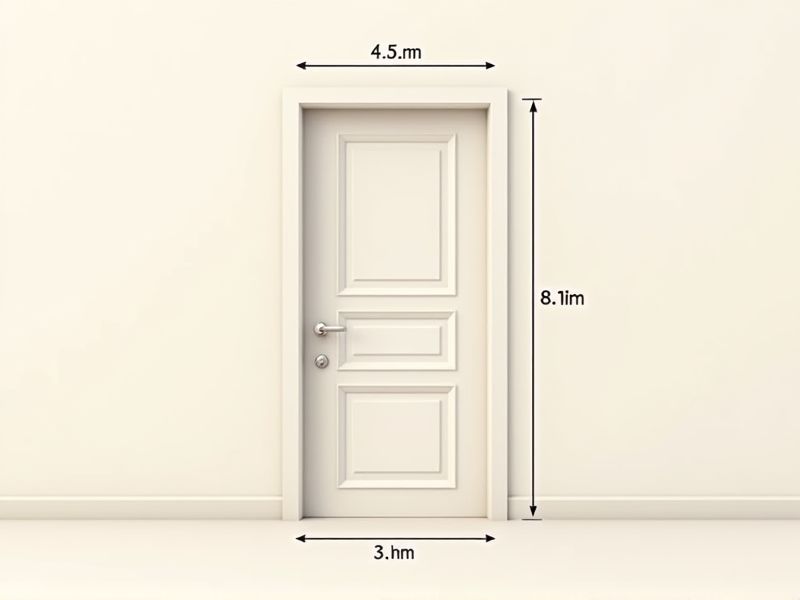
The standard dimensions for a bedroom door are typically 80 inches in height and 30 inches in width in most homes. However, widths can also commonly range from 28 to 32 inches to accommodate different layouts or accessibility needs. The door thickness is usually about 1 3/8 inches for interior doors like bedroom doors. Knowing these standard measurements is helpful when planning renovations or replacing doors to ensure a proper fit and smooth installation.
Width
The standard width for a bedroom door typically measures 32 inches, accommodating most accessibility needs while allowing ease of movement. In some cases, particularly in new construction or renovations, a wider option of 36 inches may be preferred for improved accessibility. These dimensions provide a comfortable passage width while adhering to building codes. When selecting your door, consider both the aesthetic and functional aspects to enhance your bedroom's overall design.
Height
The standard height for residential bedroom doors typically measures 80 inches (203 centimeters). However, custom designs may vary, with some doors reaching heights of 84 inches (213 centimeters) or more for a grander appearance. When selecting a door, consider factors such as ceiling height and any potential accessibility needs, particularly for those requiring wider or taller door frames. Ensuring your bedroom door adheres to these standard dimensions enhances both aesthetic appeal and functionality within your home.
Thickness
The standard thickness for interior bedroom doors typically ranges from 1.375 inches (34.925 mm) to 1.75 inches (44.45 mm). A thicker door, usually around 1.75 inches, provides better sound insulation, ensuring a quieter environment. Many homeowners opt for solid-core doors, which weigh more and are more durable compared to hollow-core options. If you're looking to enhance privacy and reduce noise, consider upgrading to a thicker door to improve the overall comfort of your bedroom.
Material
The standard bedroom door typically uses solid wood, hollow core, or fiberglass materials, each offering distinct benefits. A solid wood door provides superior insulation and durability, often enhancing the aesthetic appeal of your home with its natural grain and finishes. In contrast, a hollow core door, usually made with a plywood or MDF frame, is lightweight and cost-effective, ideal for interior spaces where soundproofing is not a priority. Fiberglass doors, known for their resistance to moisture and warping, are becoming increasingly popular, especially in regions with high humidity, allowing for both style and functionality in your bedroom design.
Swing Direction
The standard swing direction for bedroom doors typically follows the principle of opening into the room, providing maximum space and accessibility. A right-hand swing means the door hinges are on the right side when facing the door from outside, while a left-hand swing indicates hinges on the left. When considering a 36-inch wide door, this standard ensures compliance with accessibility guidelines, allowing for unobstructed movement. For optimal safety and privacy, ensure the door clears any furniture by maintaining at least 1 inch of clearance during the swing arc.
Clearance Space
A standard bedroom door typically requires a clearance space of at least 30 inches (76 cm) in width to ensure smooth operation. When considering the height, a typical door measures around 80 inches (203 cm), allowing for adequate clearance above, especially in areas with high foot traffic. It's essential to account for additional space, approximately 2 to 3 inches (5 to 8 cm), on the sides to accommodate any door trim or moldings. Ensuring proper clearance not only facilitates easy access but also helps while moving furniture in and out of your bedroom.
Frame Size
A standard bedroom door typically measures 80 inches in height and 30 inches in width, designed to fit within a frame that accommodates these dimensions. The frame size generally has a rough opening of 82 inches by 32 inches, allowing for proper installation and clearance. Common materials for bedroom door frames include wood, metal, and fiberglass, each providing varying degrees of durability and aesthetic appeal. When considering the frame thickness, it usually ranges from 4 9/16 inches to 6 9/16 inches, essential for ensuring structural integrity and a seamless fit.
Handle Type
When selecting a bedroom door, consider the handle type for both functionality and aesthetics. Lever handles are popular for their ease of use, particularly for those with mobility challenges, while round knobs offer a classic design. The height of the handle is typically set at 36 inches from the floor, ensuring accessibility for most users. With various finishes available, including brushed nickel and oil-rubbed bronze, your choice of door handle can significantly enhance the overall look of your space.
Lock Type
When selecting a bedroom door, consider the lock type for enhanced security and privacy. The most common options include privacy locks, which can be engaged from the inside and require a key for access; deadbolts, offering additional protection with a sturdy locking mechanism; and keypad locks, which provide keyless entry for convenience. The average cost for a good quality privacy lock ranges from $20 to $50, while deadbolts may start at $30 and go up depending on the brand and features. Assess your security needs to choose the most suitable lock type for your bedroom door.
Ada Compliance
A standard bedroom door with a focus on ADA compliance should have a minimum clear opening width of 32 inches when the door is open at a 90-degree angle. The threshold height must not exceed 1/2 inch to facilitate easy access for individuals with mobility impairments. Additionally, the door should feature an adjustable lever handle or pull that requires no more than 5 pounds of force to operate, promoting usability for everyone. To enhance visibility, consider using a contrasting color for the door against the wall, aiding individuals with visual impairments.
